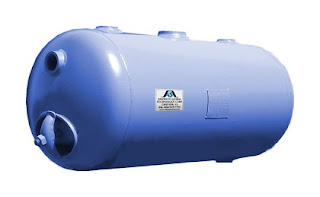 |
| hydropneumatic tank |
Burke / LaRose did little more than crib her information from the web, in particular a page from the Washington State Department of Health, where you can find the un-misinterpreted information (in full). Alex's ignorance of the topic is evident from the first sentence:
"Tanks that use water and air under pressure are referred to as a hydropneumatic tanks, or pressure tanks."While accurate, her definition doesn't address the second sentence of her source, which notes the key difference from a hydropneumatic tank and the tanks found in most residential wells: "It does not have a bladder and air is in direct contact with the water." One can only assume that Alex doesn't know that the "direct contact" information is definitive, since in a bladder tank the air and water are kept separate.
More ignorance appears as Burke explains the "functions" (as she calls them) of a hydropneumatic tank, in particular her point 2:
"There are three functions for hydropneumatic tanks... The second uses the pressure setting to monitor a pump from turning on too often."That's a weird way of saying that large hydropneumatic tanks don't cycle whenever there is " a minor call for water." Presumably that clumsiness is because neither Burke nor her content editor understood pressure limit switches
More goofiness follows in Melissa's description of the tank's design:
"There are openings at either end of the tank; one is a tank access opening (where the water enters the tank), and at the other end is the pressure gauge and pressure switch (which controls the well pump)."Alex got that notion from a picture on her source, one she clearly didn't understand. The reality is that a tank has an inlet and an outlet, both of which are controlled by valves to maintain pressure in the tank. The two may or may not be at opposite ends of the tank. And the access opening? that's for repairs and maintenance! Then there's this...
"The compressor triggers and pumps air into the tank when the water falls below the water level sensor and the air pressure falls below the setting on the pressure switch."That reads as though the compressor continues to add air to the tank until all the water is gone... Umm, no, Alex, just because the source didn't say anything about water coming through the inlet doesn't mean that the tank doesn't draw water from a well or other water supply!
Nope, it's pretty clear that our Dumbass of the Day had no idea what a hydropneumatic tank is before copying and rewording her source, and precious little afterwards – just like her readers.
copyright © 2020-2022 scmrak
DD - MECHANICS
No comments:
Post a Comment